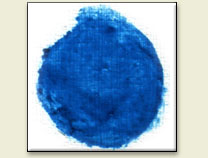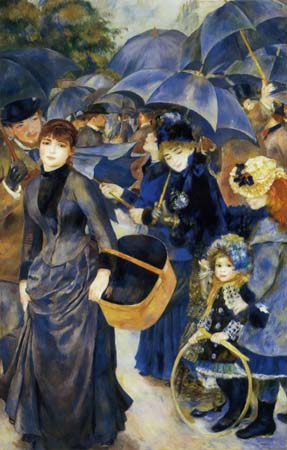
Brief description of Cobalt blue:
It's a cobalt oxide-aluminum oxide. Very costly and extraordinary stable pigment of pure blue colour discovered by Thénard in 1802. It is now the most important of the cobalt pigments. Although smalt, a pigment made from cobalt blue glass has been known at least since the Middle Ages, the cobalt blue established in the nineteenth century was a greatly improved one.
Vincent van Gogh declared to his brother Teo, ‘Cobalt [blue] is a divine colour and there is nothing so beautiful for putting atmosphere around things…"
Names for Cobalt blue:
| Alternative names: | Thénards blue, Dresden blue | ||||||
| Word origin: | The name "Cobalt blue" comes from Middle High German kobolt = an underground goblin (cobalt was thought to be detrimental to silver ores). | ||||||
| Non-English names: |
|
||||||
| Origin: | artificial | ||||||
| Chemical name: | Cobalt(II) oxide-aluminum oxide |
Example of use by artists:
|
A painting witnesses Renoir's shifts from cobalt blue to the new and more cheap artificial ultramarine
This painting was painted during the restless period in Renoir's work. It is immediately apparent that the picture exhibits two distinct styles. The group of figures on the right is painted in a soft feathery style reminiscent of his work of the later 1870s, while the umbrellas and the couple on the left are painted in a harder manner with more distinct outlines and subdued steely colors. The exact date of the painting is not known, but it is generally accepted that it was worked on over a period of several years. Notice how the fashions illustrated in the Umbrellas differs. The women in Renoir's paintings are usually dressed in the latest styles. The dresses and hats worn by the figures at the right conform to a fashion that appeared in 1881 and which became popular in 1882. The vogue was superseded the following year by a more sever style of dress with simple straight lines. THe woman with the band-box is dressed in this latter style which was the height of fashion in 1885-6, but which had fallen out of favor by 1887. Renoir appears to have changed his palette significantly between the two stages. Examination of the cross-sections has shown that in the earlier phase he used exclusively cobalt blue, available from 1802, his habitual choice during the 1870's and early 1880's, but in finishing and revising the composition he used only artificial ultramarine which came in use in the 1870s. |
(intro) - Azurite - Cerulean Blue - Cobalt blue - Egyptian blue - Prussian blue - Smalt - Ultramarine


